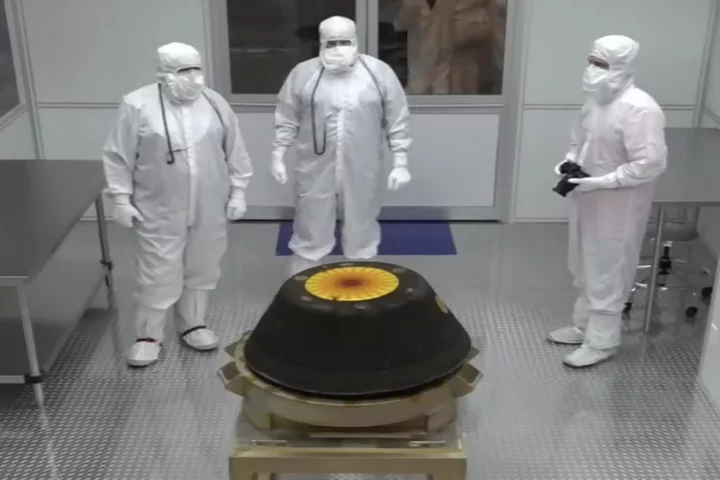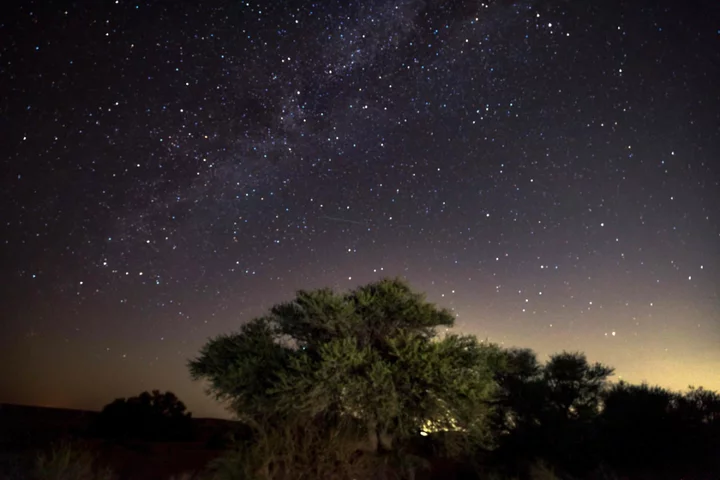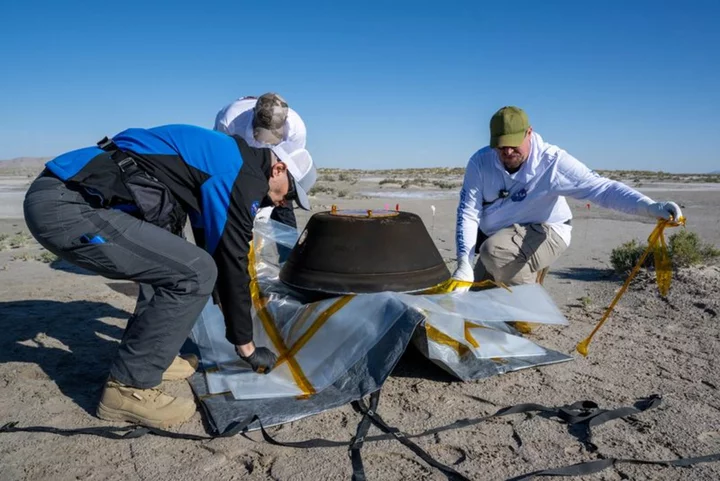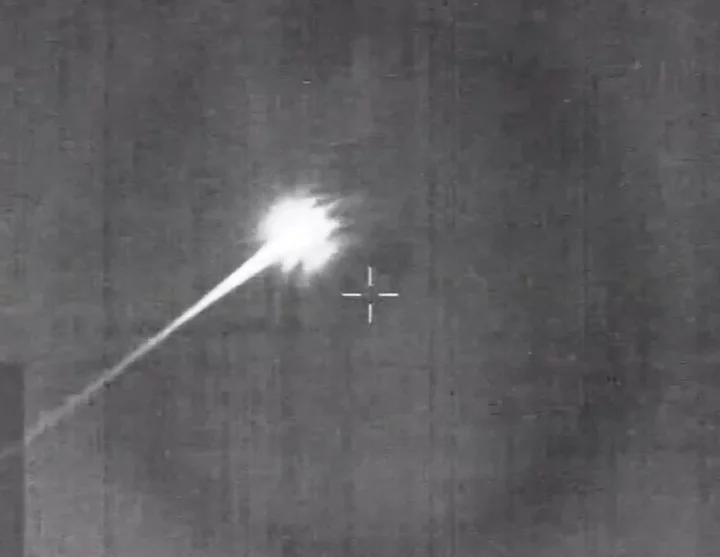
US judge refuses to block venture capital fund's grants for Black women
By Nate Raymond (Reuters) -A federal judge in Atlanta on Tuesday rejected a bid by the anti-affirmative activist behind the
2023-09-27 02:25

Humans of New York's Brandon Stanton wades into India copyright row
Humans of Bombay, which follows the same format as the New York blog, is suing a similar Indian platform.
2023-09-26 12:16

Premier League records: Heaviest home defeats of all time
Sheffield United lost 8-0 to Newcastle United at Bramall Lane yesterday but the Blades are not the only side to suffer a heavy defeat at home.
2023-09-26 03:50

Conservative activist uses Civil War-era law to challenge US corporate diversity
By Nate Raymond The anti-affirmative action activist behind the successful U.S. Supreme Court challenge to race-conscious college admissions
2023-09-26 03:26

Scientists develop simple test to help us find alien life
Scientists have developed a simple test in the search for alien life, they claim. The breakthrough helps the search for the “holy grail” of astrobiology: a reliable test that will determine whether there is or was life on other planets. The discovery uses artificial intelligence to determine with 90 per cent accuracy whether a sample is biological or not. And it could be used on existing samples, researchers say. That might mean, for instance, that we already have gathered the samples that could tell us whether there is life on Mars. Scientists hope that their test could be used on samples already collected by the Mars Curiosity rover’s Sample Analysis at Mars (SAM) instrument. The rover has an instrument on board to analyse those samples, and that data could be used in the test. The findings could also help tell us more about our own planet, revealing the history of mysterious and ancient rocks found on Earth. “The search for extraterrestrial life remains one of the most tantalizing endeavors in modern science,” said lead author Jim Cleaves of the Earth and Planets Laboratory, Carnegie Institution for Science, Washington, DC. “The implications of this new research are many, but there are three big takeaways: First, at some deep level, biochemistry differs from abiotic organic chemistry; second, we can look at Mars and ancient Earth samples to tell if they were once alive; and third, it is likely this new method could distinguish alternative biospheres from those of Earth, with significant implications for future astrobiology missions.” The technique does not look for specific molecules or compounds that could be indicative of life, as much previous work has done. Instead, it looks for small differences in the molecular patterns of samples using different kinds of analysis. It was built by giving an artificial intelligent system data about 134 known samples, with information about whether they are biotic or abiotic. To test it, it was then given new samples – including those from living things, remnants of ancient life and other abiotic samples that did not point to life, such as pure chemicals – and identified them with 90 per cent accuracy. The system also started predicting another kind of sample type, dividing the biotic ones into “living” and “fossils”. That means it could tell the difference between a freshly harvested leaf and something else that died long ago, for instance. Scientists hope that with time it could eventually be able to distinguish other hints in the data, such as signs of photosynthesis or cells that have a nucleus. Previous research has struggled because organic molecules tend t degrade over time. But the new method works even when the samples have decayed and changed significantly, the researchers behind it said. “This routine analytical method has the potential to revolutionize the search for extraterrestrial life and deepen our understanding of both the origin and chemistry of the earliest life on Earth,” said Robert Hazen, of the Carnegie Institution for Science, one of the leaders of the research. “It opens the way to using smart sensors on robotic spacecraft, landers and rovers to search for signs of life before the samples return to Earth.” The findings could also help solve mysteries on life. Many ancient rocks on Earth are at the middle of argument over whether they hold the oldest fossil microbes in life, while others say they do not have any life – and researchers are already feeding data about those rocks from Australia, Canada and elsewhere into the tool. “We’re applying our methods right now to address these long-standing questions about the biogenicity of the organic material in these rocks,” Hazen says. A paper describing the work, ‘A robust, agnostic biosignature based on machine learning’, is published in the Proceedings of the National Academy of Sciences. Read More New discovery is ‘holy grail’ breakthrough in search for aliens, scientist say Nasa has gathered a large piece of a distant asteroid. What now? Nasa spots shocking number of galaxies like our own New discovery is ‘holy grail’ breakthrough in search for aliens, scientist say Nasa has gathered a large piece of a distant asteroid. What now? Nasa spots shocking number of galaxies like our own
2023-09-26 03:19

Nasa has gathered a large piece of a distant asteroid. What now?
Scientists have gathered a significant chunk of a distant asteroid, which has made its way to Earth after a mission taking millions of miles. But the really useful work will begin now. Nasa’s Osiris-Rex mission flew to the distant Asteroid Bennu, scooped up a piece of the object into a canister, and then flew back to Earth to drop it off. On Sunday, Nasa picked up that canister in the Utah desert and is now working to secure it. It will then send those samples to a variety of scientists around the world, with a chunk of it being sent to more than 200 people at 38 different institutions across the world. They hope that they can use them as a “time capsule” to peer into the early universe, telling us about where we came from. “This box when it is opened of material from the surface of Bennu can tell us untold secrets of the origins of the universe, the origins of our planet and the origins of life itself,” said Queen musician Brian May, who helped with the research by mapping out the asteroid to find a landing spot. “What an incredibly exciting day.” Sample return missions are particularly exciting to scientists because they offer a look at a pristine piece of a distant world that has been undisturbed by the environment on Earth. While some pieces of asteroids and other objects can fall down to Earth, they have to make their way through the atmosphere and can be damaged and changed in the process. They also mean that researchers are able to use all of the Earth’s latest technology to study the sample. Other pieces of distant worlds have of course been studied by spacecraft and landers, but they are only able to do so with the limited instruments they take to those planets. Another advantage of sample return missions over studying the objects at their home is that scientists can look back at those samples with new sensors and equipment invented long after the sample was actually taken. Many space missions continue for years – Curiosity is still examining Mars after arriving there in 2012, and the Voyager probes are still providing information almost 50 years after they were launched – but they are only able to do so with the technology that was available when they set off. The analysis done in sample return missions really begins when the spacecraft arrives at its target: then, it starts looking at the context of the sample, gathering information about the world from which it came that should prove useful to scientists later. Osiris-Rex arrived at Bennu in 2018, and spent two years mapping the asteroid before it set off back home with its delivery. All of that information in addition to the samples could help answer a variety of questions about our planet, scientists hope. “The asteroids in our solar system contain the raw building blocks from which the Earth was made, so working out their composition will tell us a lot of how our planet formed,” said Boris Gansicke from the department of physics at the University of Warwick. “There are many open questions, for instance, where did the water that we have on Earth come from? And where did the ingredients that made life possible to develop come from? “To answer those questions, ie measure the composition of an asteroid, you need to get your ‘hands’ on them (or in this case the arm of a space mission), and this is what Osiris-Rex achieved. “In a nutshell, it’s similar to sitting in front of a delicious dinner and wanting to have the list of ingredients.” Sample return missions are almost as old as space travel itself, and the first of them were the early Apollo missions, which brought back pieces of the Moon. Those continue to be useful to scientists. Since then, as human travel into space has declined, most of the work has been done by robots. In the early 1970s, the Soviet Union’s Luna missions gathered pieces of the Moon and brought them back, and in 2020 Japan’s Hayabusa2 mission brought back pieces of the asteroid Ryugu. Scientists have high hopes for future missions: perhaps the most discussed is a mission to Mars, which would bring back the first ever pieces of that planet. Engineers have suggested that for decades, and a number of plans have been formed, but none are likely to launch any time soon. Read More Nasa spots shocking number of galaxies like our own Nasa lands Bennu asteroid samples back on Earth Nasa just delivered a piece of a distant asteroid to Earth Pieces of a distant asteroid are about to fall to Earth Nasa to return largest asteroid sample ever as UK helps with research Massive solar flare strikes Nasa spacecraft sent to study Sun
2023-09-26 00:59

How the Taylor Swift and Travis Kelce connection started with a friendship bracelet
Taylor Swift fans have famously worn and traded personalized friendship bracelets, typically featuring the names of her songs and albums, throughout the US-leg of her "Eras" tour. So when Swift played Arrowhead Stadium in July, Kansas City Chiefs' tight end Travis Kelce said he made a play for Swift by attempting to give her a friendship bracelet with his phone number.
2023-09-26 00:49

Nasa spots shocking number of galaxies like our own in early universe
Scientists have spotted a shocking number of galaxies like our own in the early universe. The finding will prompt us to entirely rethink our understanding of how the universe formed the structures that surround us. Looking deep into space, scientists found that the galaxies we see in the early universe are much more like our own Milky Way than was thought possible. A team of international researchers including those at The University of Manchester and University of Victoria in Canada, used the James Webb Space Telescope (JWST) to discover that galaxies like the Milky Way are 10 times more common than what was believed based on previous observations with the Hubble Space Telescope. Many of these galaxies formed some 10 billion years ago or longer, going far back into the history of the universe. The Milky Way is a typical disk galaxy, with a shape similar to a pancake or compact disc, rotating about its centre and often containing spiral arms. These galaxies might be the kind where life can develop given the nature of their formation history, experts suggest. Astronomers previously considered these types of galaxies too fragile to exist in the early universe when galaxy mergers were more common, destroying what was thought to be their delicate shapes. Christopher Conselice, professor of extragalactic astronomy at The University of Manchester, said: “Using the Hubble Space Telescope we thought that disc galaxies were almost non-existent until the universe was about six billion years old, these new JWST results push the time these Milky Way-like galaxies form to almost the beginning of the universe.” He added: “These JWST results show that disc galaxies like our own Milky Way, are the most common type of galaxy in the universe. “This implies that most stars exist and form within these galaxies which is changing our complete understanding of how galaxy formation occurs. “These results also suggest important questions about dark matter in the early universe which we know very little about.” “Based on our results, astronomers must rethink our understanding of the formation of the first galaxies and how galaxy evolution occurred over the past 10 billion years.” The researchers say their findings, published in the Astrophysical Journal, completely overturn the existing understanding of how scientists think the universe evolves, and the scientists say new ideas need to be considered. Lead author Leonardo Ferreira, from the University of Victoria, said: “For over 30 years it was thought that these disc galaxies were rare in the early universe due to the common violent encounters that galaxies undergo. “The fact that JWST finds so many is another sign of the power of this instrument and that the structures of galaxies form earlier in the universe, much earlier in fact, than anyone had anticipated.” The improved technology of JWST allows astronomers to see the true structure of these galaxies for the first time. A paper describing the findings, ‘The JWST Hubble Sequence: The Rest-Frame Optical Evolution of Galaxy Structure at 1.5 The Astrophysical Journal. Additional reporting by agencies Read More Nasa just delivered a piece of a distant asteroid to Earth Nasa lands Bennu asteroid samples back on Earth Pieces of a distant asteroid are about to fall to Earth Nasa just delivered a piece of a distant asteroid to Earth Nasa lands Bennu asteroid samples back on Earth Pieces of a distant asteroid are about to fall to Earth
2023-09-26 00:19

Kosovo and Serbia row over monastery gun battle
A Kosovan policeman and three ethnic Serb gunmen are dead after a siege of a monastery in Kosovo.
2023-09-25 09:26

NBA rumors: Buddy Hield trade, Celtic on the block, Embiid's big decision
The latest slate of NBA rumors involves a Buddy Hield suitor, potential Celtics trade bait, and Joel Embiid's looming decision.
2023-09-25 08:25

NASA's first asteroid sample parachutes into Utah desert
By Steve Gorman and Maria Caspani (Reuters) -A NASA space capsule carrying the largest soil sample ever scooped up from
2023-09-25 03:50

Pieces of distant, ancient asteroid arrive on Earth from Nasa spacecraft, after travelling billions of miles
A piece of asteroid has arrived on Earth from the other side of the solar system, in a major success for Nasa’s Osiris-Rex mission. The spacecraft has spent years flying to Asteroid Bennu, gathering up a piece of it, and bringing it back home so that it can be studied by researchers. It brings an end to a mission that took seven years, saw it travel 4 billion miles, and cost more than a billion dollars. Scientists hope that study can help reveal how planets formed and evolved, and might shed light on how life itself began. Since Bennu is around 4.5 billion years old, the sample is almost like a look back into the solar system during its early years and Nasa has referred to it as a “time capsule”. Asteroid Bennu is also notable as Nasa’s “most dangerous asteroid”, according to a scale used to measure how much of a hazard a given object poses. It is the first time that Nasa has brought back a piece of an asteroid, and the first time since 2020. It is also the biggest ever to be gathered, at around 250 grams. Nasa sent a team on board helicopters to gather the sample canister, extracting it to ensure that it did not become contaminated by the environment. Since the sample was directly from the asteroid, it will not have any trace of material from the Earth on it, unlike those that fall to Earth. That sample will be distributed between 200 people at 38 institutions across the world, including those in the UK. The Osiris-Rex mission left Earth in September 2016, and arrived at the asteroid in October 2018. It gathered samples in October 2020, and then left the asteroid in April 2021. Since then, both the sample and the spacecraft have been returning back from the other side of the solar system to Earth. The spacecraft then dropped off the sample to return home, while Osiris-Rex will carry on to study another asteroid called Apophis, where it will arrive in 2029. Apophis is also notable for its danger: at times, it has challenged Bennu at the top of the league table of most dangerous objects. But recent research has suggested that Apophis poses less of a danger. Ashley King, UKRI future leaders fellow, Natural History Museum, said: “Osiris-Rex spent over two years studying asteroid Bennu, finding evidence for organics and minerals chemically altered by water. “These are crucial ingredients for understanding the formation of planets like Earth, so we’re delighted to be among the first researchers to study samples returned from Bennu. ‘We think the Bennu samples might be similar in composition to the recent Winchcombe meteorite fall, but largely uncontaminated by the terrestrial environment and even more pristine.” Dr Sarah Crowther, research fellow in the Department of Earth and Environmental Sciences at the University of Manchester, said: “It is a real honour to be selected to be part of the Osiris-Rex sample analysis team, working with some of the best scientists around the world. “We’re excited to receive samples in the coming weeks and months, and to begin analysing them and see what secrets asteroid Bennu holds. “A lot of our research focuses on meteorites and we can learn a lot about the history of the solar system from them. “Meteorites get hot coming through Earth’s atmosphere and can sit on Earth for many years before they are found, so the local environment and weather can alter or even erase important information about their composition and history. “Sample return missions like Osiris-Rex are vitally important because the returned samples are pristine, we know exactly w Read More Pieces of a distant asteroid are about to fall to Earth Nasa to return largest asteroid sample ever as UK helps with research Astronomers find abundance of Milky Way-like galaxies in early universe Pieces of a distant asteroid are about to fall to Earth Nasa to return largest asteroid sample ever as UK helps with research Astronomers find abundance of Milky Way-like galaxies in early universe
2023-09-24 23:20
